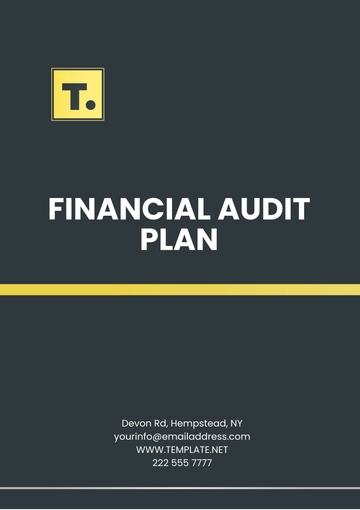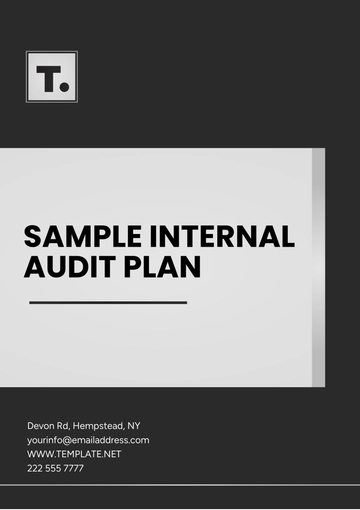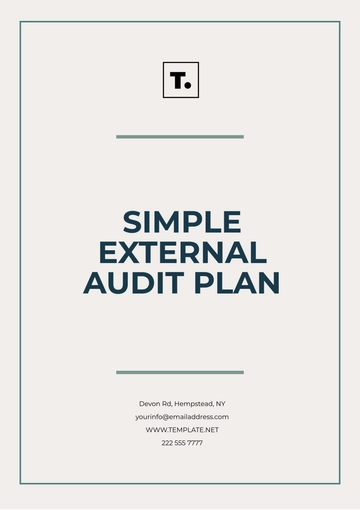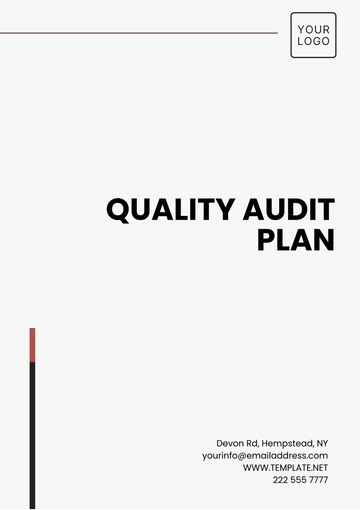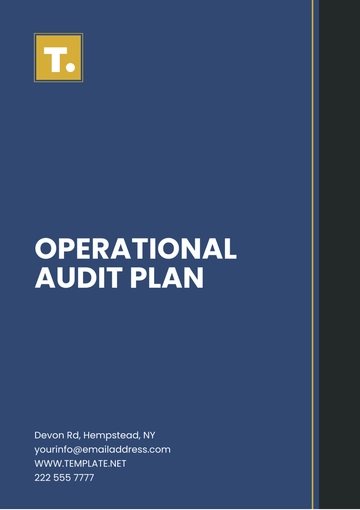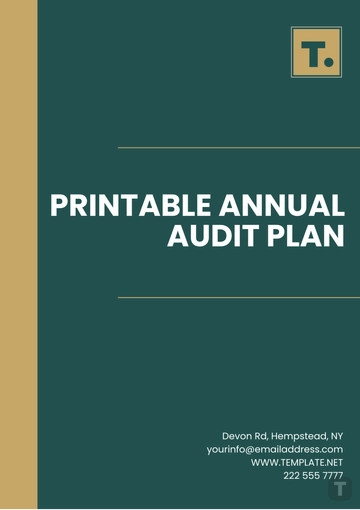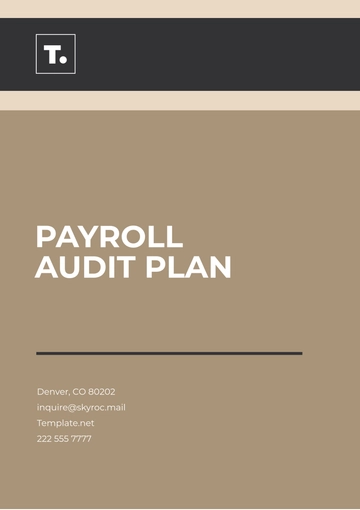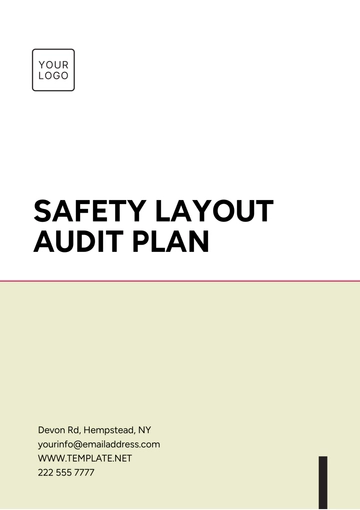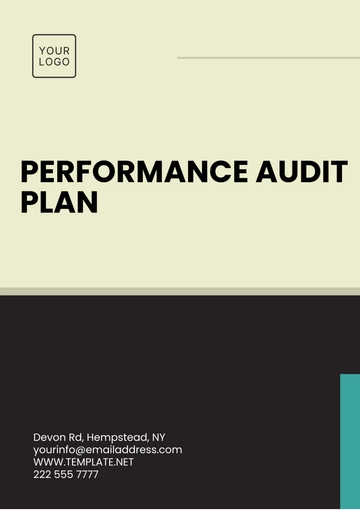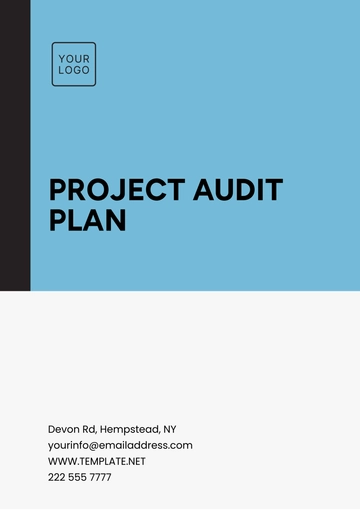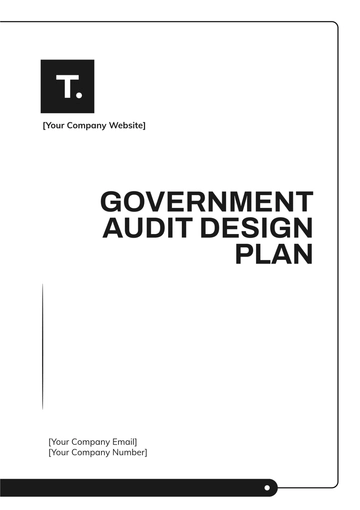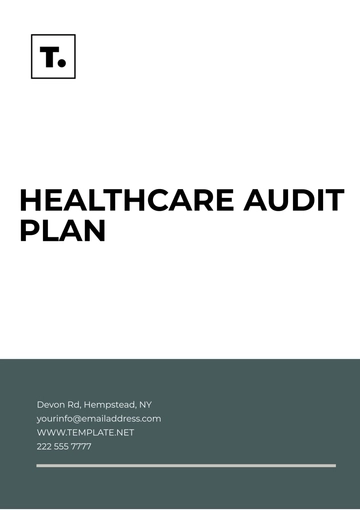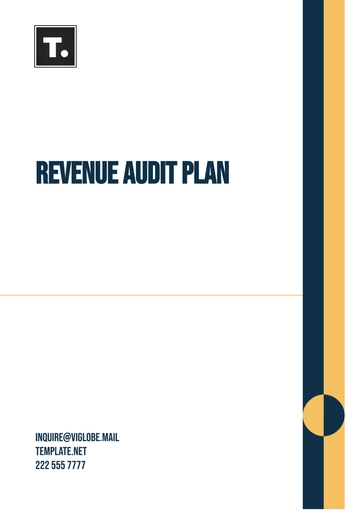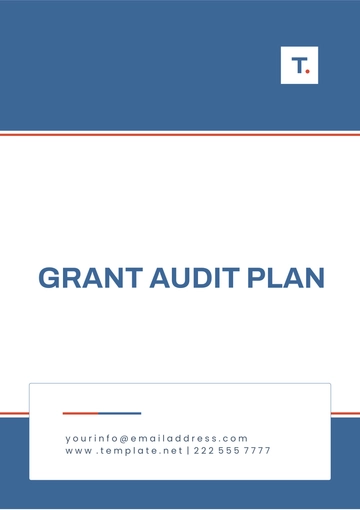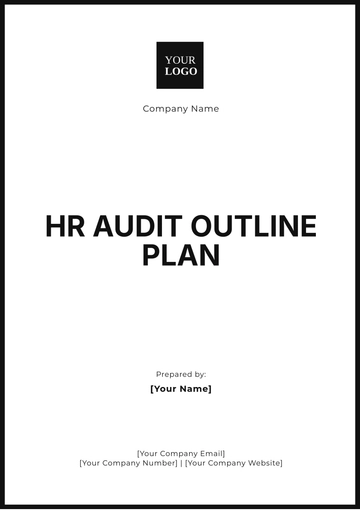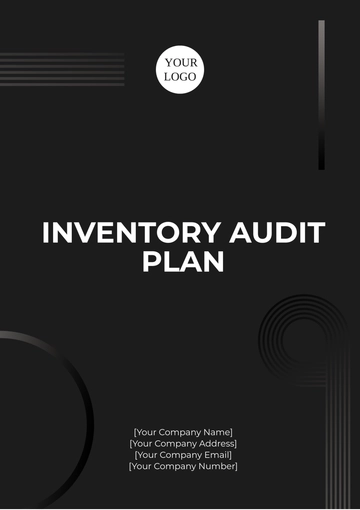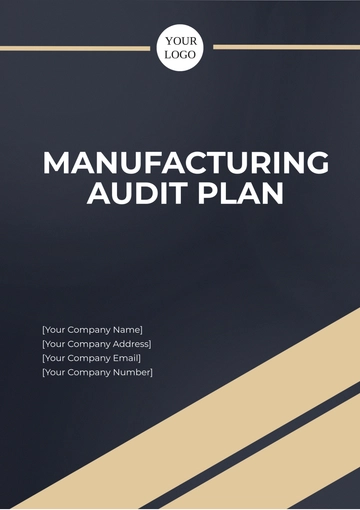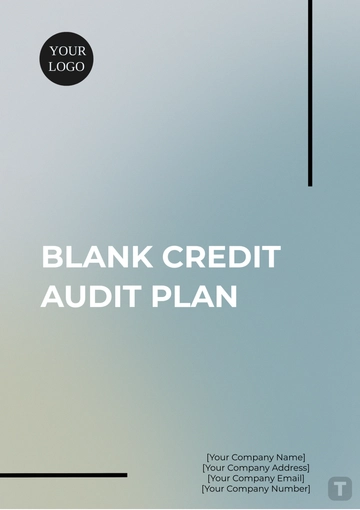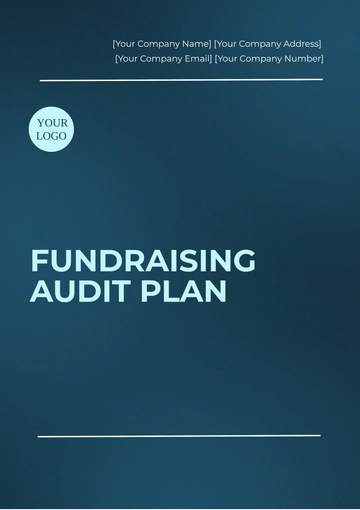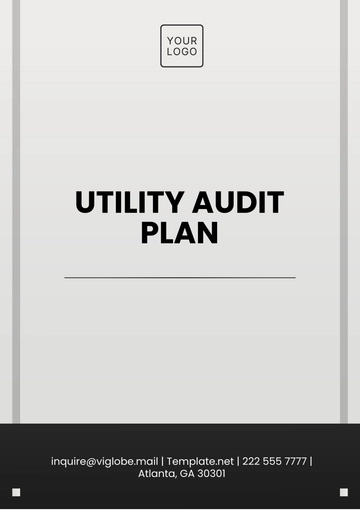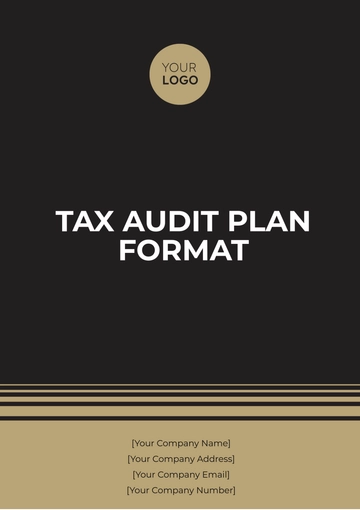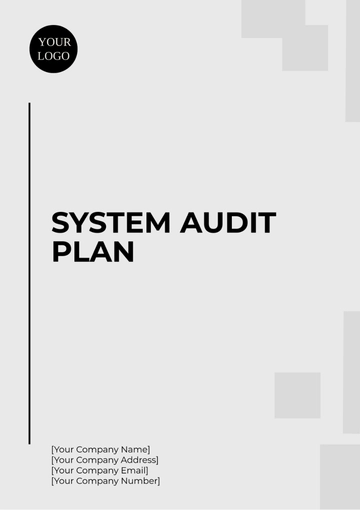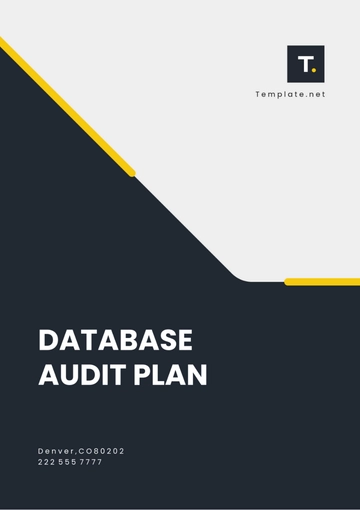Free Finance Long-Term Audit Plan

TABLE OF CONTENTS
I. Audit Scope and Objectives
II. Risk Assessment and Prioritization
A. Risk Identification
B. Audit Prioritization
III. Audit Schedule and Timeline
A. Audit Calendar
B. Timeline Flexibility
IV. Resource Allocation and Budgeting
A. Resource Planning
B. Budget Allocation
V. Monitoring and Evaluation Mechanisms
A. Monitoring Process
B. Evaluation and Adjustment
I. Audit Scope and Objectives
Goals of the Plan: The primary goals of this Long-Term Audit Plan at [Your Company Name] are threefold. First, to provide comprehensive financial oversight, ensuring that every financial activity aligns with both our internal standards and external regulatory requirements. Second, to systematically identify and address areas for operational improvements, thereby enhancing efficiency and effectiveness across the company. Finally, to maintain strict adherence to all relevant regulatory standards, safeguarding the company against compliance risks. Over the next five years, this plan aims to foster a culture of financial integrity and continuous improvement, positioning [Your Company Name] for sustained growth and success in an increasingly competitive and regulated business environment.
Scope of Audits: The scope of this audit plan is extensive and all-encompassing, designed to cover every major financial domain within [Your Company Name]. This includes a thorough examination of internal controls to ensure they are robust and effective, an in-depth analysis of both revenue and expenditure cycles to identify any inefficiencies or inaccuracies, a rigorous review of compliance with all applicable tax laws, and an accurate assessment of financial reporting practices to ensure their utmost accuracy and transparency.
Each department within the company, from Sales to Operations, Human Resources to Marketing, will undergo at least one detailed financial audit within the five years. This wide-ranging approach ensures that no aspect of our financial operations is overlooked, providing a holistic view of the company's financial health and operational efficiency.
II. Risk Assessment and Prioritization
In this section, we detail the identification of key risk areas and the prioritization of audits for [Your Company Name]. This approach ensures that resources are allocated effectively to areas of highest risk and regulatory importance.
A. Risk Identification
A risk matrix will be developed to identify areas such as cash flow management, credit risks, and regulatory compliance as high-risk zones.
Risk Area | Description | Estimated Risk Percentage |
Cash Flow Management | Risk of cash flow interruptions impacting operational capabilities. | 25% |
Credit Risks | Risk associated with extending credit to customers. | 20% |
Regulatory Compliance | Risk of non-compliance with financial regulations. | 30% |
Cybersecurity Threats | Risk of financial data breaches and cyber attacks. | 15% |
Fraudulent Activities | Internal or external fraudulent financial activities. | 10% |
B. Audit Prioritization
Based on the risk matrix, initial audits will focus on high-risk areas, followed by audits of areas with less perceived risk. Regulatory mandated audits will be scheduled as per legal requirements.
Audit Type | Priority Level | Estimated Risk Coverage | Legal Requirement |
Compliance Audit | High | 30% | Mandatory as per SOX Act |
Financial Statement Audit | Medium | 25% | Mandatory for public reporting |
Operational Audit (Cash Flow) | High | 25% | Not legally required, but critical |
Credit and Collections Audit | Medium | 20% | Not legally required, but advised |
IT and Cybersecurity Audit | High | 15% | Advised due to rising cyber threats |
This structured assessment of risks and audit prioritization is designed to guide [Your Company Name] in focusing its audit efforts where they are most needed. By addressing high-risk areas and fulfilling legal audit requirements first, the company can better manage its risks and ensure compliance with all necessary financial regulations.
III. Audit Schedule and Timeline
The Finance Long-Term Audit Plan for [Your Company Name] includes a carefully structured audit calendar and a flexible timeline approach, ensuring that audits are conducted in a timely and responsive manner.
A. Audit Calendar
A five-year audit calendar will be created, scheduling different audits throughout the period. Each audit will be allocated a timeframe based on its complexity – ranging from one month for straightforward audits to three months for more complex ones.
Year | Audit Type | Scheduled Month(s) | Duration |
Year 1 | Compliance Audit | January - February | 2 Months |
Financial Statement Audit | March - April | 2 Months | |
Year 2 | Operational Audit (Cash Flow) | May - June | 2 Months |
Credit and Collections Audit | July | 1 Month | |
Year 3 | IT and Cybersecurity Audit | August - September | 2 Months |
Compliance Audit | October - November | 2 Months | |
Year 4 | Financial Statement Audit | December - January | 2 Months |
Operational Audit (Cash Flow) | February - March | 2 Months | |
Year 5 | Credit and Collections Audit | April | 1 Month |
IT and Cybersecurity Audit | May - June | 2 Months |
B. Timeline Flexibility
The schedule will be reviewed annually to accommodate any emergent issues or changes in business operations or regulatory requirements. This is essential to assess and adjust the upcoming year's audit schedule based on any emergent issues, significant changes in business operations, or updates in regulatory requirements. This review ensures that the audit plan remains relevant and aligned with the company's current needs and external compliance obligations
IV. Resource Allocation and Budgeting
This section of the Finance Long-Term Audit Plan for [Your Company Name] outlines the strategic allocation of resources and budgeting for the planned audits. These allocations ensure that each audit is sufficiently resourced to be effective and efficient.
A. Resource Planning
Adequate staffing, including internal auditors and external experts where necessary, will be planned for each audit. Technological resources, such as auditing software, will also be allocated.
Audit Type | Internal Auditors | External Experts | Technological Resources | Additional Key Roles |
Compliance Audit | 3 Internal Auditors | 1 Legal Compliance Expert | Compliance Software | 1 Compliance Manager |
Financial Statement Audit | 4 Internal Auditors | 1 Accounting Expert | Financial Analysis Tools | 2 Financial Analysts |
Operational Audit | 2 Internal Auditors | N/A | Operational Assessment Tools | 1 Operations Specialist |
Credit and Collections Audit | 2 Internal Auditors | 1 Credit Risk Analyst | Credit Analysis Software | 1 Collections Manager |
IT and Cybersecurity Audit | 2 Internal Auditors | 1 Cybersecurity Expert | IT Security Tools | 1 IT Manager |
B. Budget Allocation
A portion of the annual financial budget will be dedicated to auditing activities. This will include costs for external audits, technology upgrades, and training programs for audit staff.
Audit Type | External Audit Costs | Technology Upgrades | Training Programs | Staffing Costs | Miscellaneous |
Compliance Audit | $15,000 | $5,000 | $3,000 | $20,000 | $2,000 |
Financial Statement Audit | $20,000 | $7,000 | $4,000 | $25,000 | $3,000 |
Operational Audit | N/A | $4,000 | $2,500 | $15,000 | $1,500 |
Credit and Collections Audit | $10,000 | $3,000 | $2,000 | $10,000 | $1,000 |
IT and Cybersecurity Audit | $12,000 | $8,000 | $5,000 | $18,000 | $2,500 |
This detailed resource and budget allocation plan ensures that each audit within the Long-Term Audit Plan for [Your Company Name] is adequately supported. By allocating internal and external expertise, technological tools, and budgetary resources, the plan aims to achieve a comprehensive and effective audit process, contributing to the overall financial integrity and compliance of the company.
V. Monitoring and Evaluation Mechanisms
The success of the Finance Long-Term Audit Plan at [Your Company Name] hinges on robust monitoring and evaluation mechanisms. These processes ensure that the plan stays on track and continues to align with the company’s evolving needs and objectives.
A. Monitoring Process
Each audit within the plan is overseen by a designated senior audit manager. This manager is responsible for ensuring that the audit team adheres to the predefined schedule and meets the audit objectives. They monitor key milestones, resource utilization, and overall progress, intervening when necessary to address delays or deviations. Regular progress reports are submitted to the company’s audit committee, providing transparency and enabling timely decision-making. The monitoring process is critical in maintaining the rigor and discipline required for successful audit execution.
B. Evaluation and Adjustment
Upon the completion of each audit, a comprehensive evaluation is conducted to assess its effectiveness. This includes analyzing the audit findings, the process efficiency, and the impact of the recommendations made. Feedback is gathered from the audit team and the audited departments to gain diverse perspectives. Based on these evaluations, along with consideration of any changes in the business environment or regulatory landscape, the audit plan is reviewed and adjusted annually. This may involve reprioritizing audits, reallocating resources, or updating audit methodologies. The goal is to ensure that the audit plan remains relevant, effective, and aligned with [Your Company Name]'s strategic goals.
Through diligent monitoring and dynamic evaluation, the Long-Term Audit Plan for [Your Company Name] is designed to be a living strategy, adaptable to the company’s changing needs and capable of delivering the utmost value in terms of financial oversight and risk management.
Created by: [Your Name]
- 100% Customizable, free editor
- Access 1 Million+ Templates, photo’s & graphics
- Download or share as a template
- Click and replace photos, graphics, text, backgrounds
- Resize, crop, AI write & more
- Access advanced editor
Maximize finance management with Template.net's Finance Long-Term Audit Plan. This editable tool streamlines financial examination, promising efficient results. Completely customizable and editable in our Ai Editor Tool, gain control over intricate financial details. Invigorate your finance strategy with this expertly-crafted guide. A tool that augments precision, enhances strategy, and empowers successful financial auditing.
You may also like
- Finance Plan
- Construction Plan
- Sales Plan
- Development Plan
- Career Plan
- Budget Plan
- HR Plan
- Education Plan
- Transition Plan
- Work Plan
- Training Plan
- Communication Plan
- Operation Plan
- Health And Safety Plan
- Strategy Plan
- Professional Development Plan
- Advertising Plan
- Risk Management Plan
- Restaurant Plan
- School Plan
- Nursing Home Patient Care Plan
- Nursing Care Plan
- Plan Event
- Startup Plan
- Social Media Plan
- Staffing Plan
- Annual Plan
- Content Plan
- Payment Plan
- Implementation Plan
- Hotel Plan
- Workout Plan
- Accounting Plan
- Campaign Plan
- Essay Plan
- 30 60 90 Day Plan
- Research Plan
- Recruitment Plan
- 90 Day Plan
- Quarterly Plan
- Emergency Plan
- 5 Year Plan
- Gym Plan
- Personal Plan
- IT and Software Plan
- Treatment Plan
- Real Estate Plan
- Law Firm Plan
- Healthcare Plan
- Improvement Plan
- Media Plan
- 5 Year Business Plan
- Learning Plan
- Marketing Campaign Plan
- Travel Agency Plan
- Cleaning Services Plan
- Interior Design Plan
- Performance Plan
- PR Plan
- Birth Plan
- Life Plan
- SEO Plan
- Disaster Recovery Plan
- Continuity Plan
- Launch Plan
- Legal Plan
- Behavior Plan
- Performance Improvement Plan
- Salon Plan
- Security Plan
- Security Management Plan
- Employee Development Plan
- Quality Plan
- Service Improvement Plan
- Growth Plan
- Incident Response Plan
- Basketball Plan
- Emergency Action Plan
- Product Launch Plan
- Spa Plan
- Employee Training Plan
- Data Analysis Plan
- Employee Action Plan
- Territory Plan
- Audit Plan
- Classroom Plan
- Activity Plan
- Parenting Plan
- Care Plan
- Project Execution Plan
- Exercise Plan
- Internship Plan
- Software Development Plan
- Continuous Improvement Plan
- Leave Plan
- 90 Day Sales Plan
- Advertising Agency Plan
- Employee Transition Plan
- Smart Action Plan
- Workplace Safety Plan
- Behavior Change Plan
- Contingency Plan
- Continuity of Operations Plan
- Health Plan
- Quality Control Plan
- Self Plan
- Sports Development Plan
- Change Management Plan
- Ecommerce Plan
- Personal Financial Plan
- Process Improvement Plan
- 30-60-90 Day Sales Plan
- Crisis Management Plan
- Engagement Plan
- Execution Plan
- Pandemic Plan
- Quality Assurance Plan
- Service Continuity Plan
- Agile Project Plan
- Fundraising Plan
- Job Transition Plan
- Asset Maintenance Plan
- Maintenance Plan
- Software Test Plan
- Staff Training and Development Plan
- 3 Year Plan
- Brand Activation Plan
- Release Plan
- Resource Plan
- Risk Mitigation Plan
- Teacher Plan
- 30 60 90 Day Plan for New Manager
- Food Safety Plan
- Food Truck Plan
- Hiring Plan
- Quality Management Plan
- Wellness Plan
- Behavior Intervention Plan
- Bonus Plan
- Investment Plan
- Maternity Leave Plan
- Pandemic Response Plan
- Succession Planning
- Coaching Plan
- Configuration Management Plan
- Remote Work Plan
- Self Care Plan
- Teaching Plan
- 100-Day Plan
- HACCP Plan
- Student Plan
- Sustainability Plan
- 30 60 90 Day Plan for Interview
- Access Plan
- Site Specific Safety Plan

